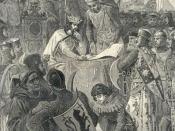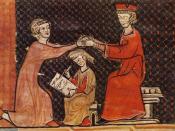There were many reasons for the downfall for the Middle Ages, but the most crucial ones were the decline of the feudal system, and the declination of the Church's power over the nation-states. In feudal society, everyone had a definite place and a definite role, with the power resting in the hands of the local lords (instead of a central government). The lords, or nobles, lost power after the Crusades, when the Europeans came into contact with the more advanced civilizations of the Byzantine Empire and the Muslims. That spurred the growth of trade, which in turn gave rise to a money system. The money system in turn caused the birth of a middle class, which didn't fit anywhere into the feudal system. It was made up of the serfs and peasants that left the feudal system in search of making money in trade. For the middle class, the king granted Charters, made a uniform law, started banking, offered protection, and expanded territory.
In return, the middle class payed taxes to the king. While this money economy grew, the feudal lords were put into an economic squeeze. As one may see, that didn't leave much of a place for the nobles, who were rapidly losing power. Another thing that contributed to their loss of power was the enforcement of Common Law, which applied throughout the kingdom.
The effects of the Hundred Years' War hastened the decline of the feudal system. The use of the longbow and firearms made the feudal methods of fighting obsolete. Monarchs replaced feudal soldiers with national armies made up of hired soldiers. Finally, threats to the monarchy decreased as a result of the large number of nobles killed in the war.
Another major factor that contributed to the end of the Middle Ages was the...



More
really good job but u might want to go a little more in depth
1 out of 1 people found this comment useful.